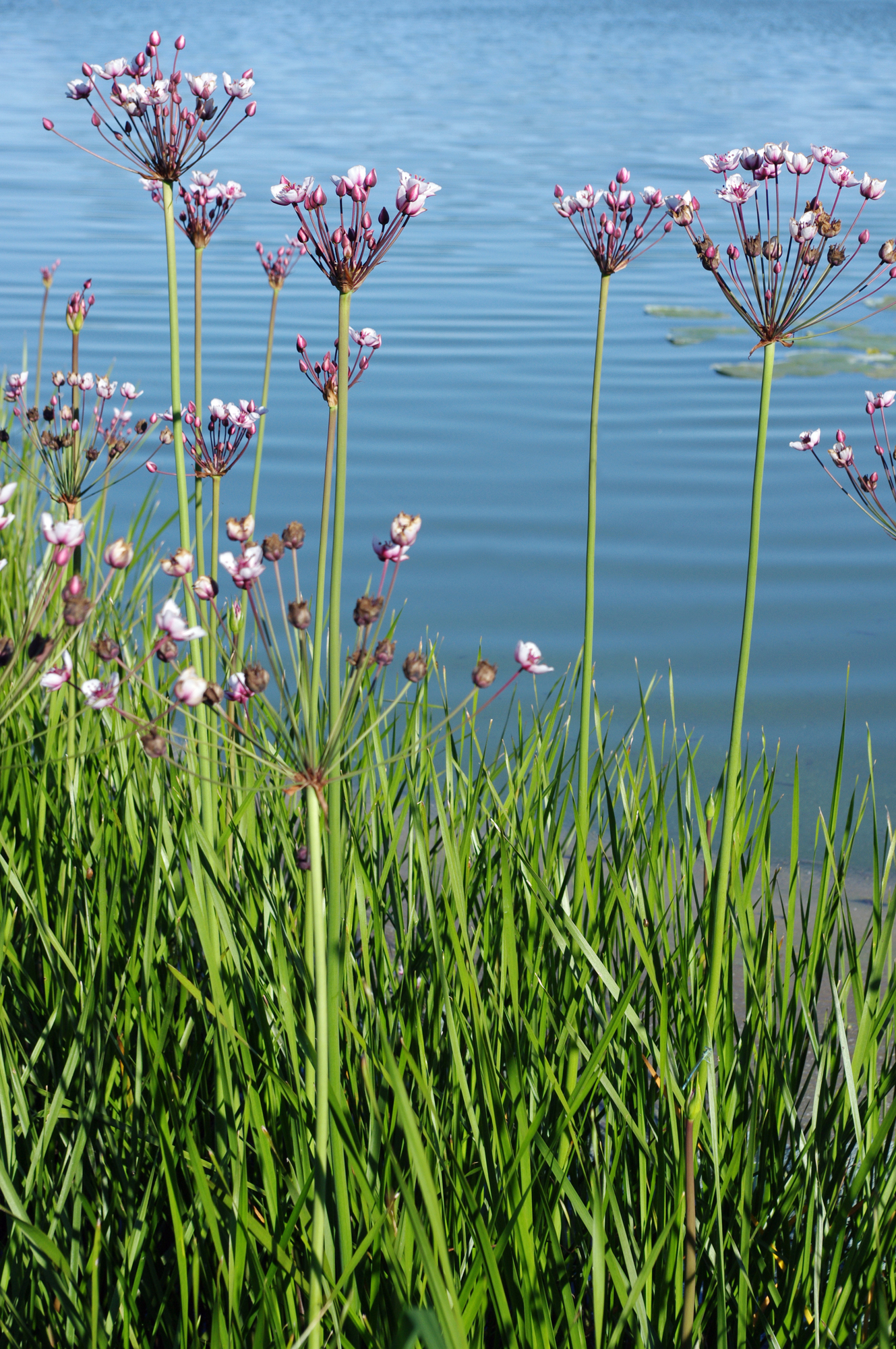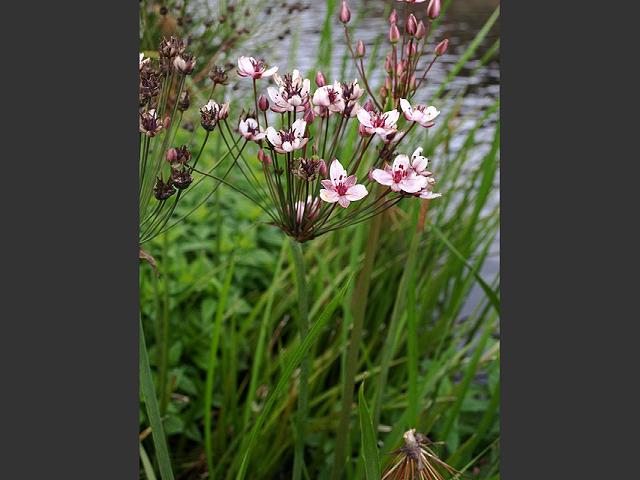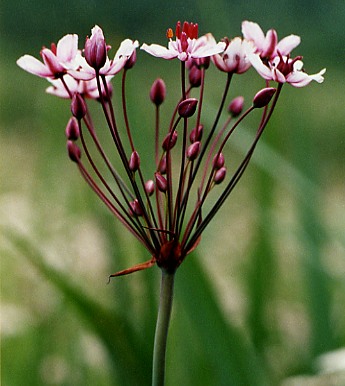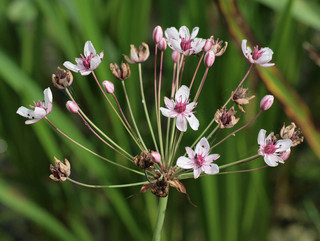Butomus umbellatus
Flowering rush ( Butomus umbellatus )
Called The Swan Flower ( Butomus umbellatus ), also water timothy, flowers rush, Doldige swan flower or Wasserviole, is the only species in the monotypic genus Butomus and the mono- generic family of swan flower plants ( Butomaceae ). It thrives as a marsh plant on water banks and in wetlands.
The Nature Conservation Foundation Hamburg chose the swan flower to flower of the year 2014.
- 5.1 Use as food and braiding
- 5.2 Use as a remedy
- 5.3 Use as an ornamental plant
- 6.1 Notes and references
Name interpretation
The trivial name Flowering probably refers to the shape of the ovary with its swan neck-like extension. The German trivial name flowers bulrush frequently used should be avoided as this can lead to confusion with Scheuchzeria palustris.
Description
Habit and foliage leaves
The swan flower grows as a perennial herbaceous plant, reaching heights of growth from 50 to 150 centimeters. It is a short, white, crawling, monopodiales, up to 1 cm thick rhizome available; Foothills are missing. It contains clear milky juice.
The leaves are at the base of and more or less double spaced. The leaves are divided at least in leaf sheath and blade, a petiole may be present. The shape of the leaves is dependent on water levels: Is the plant in deeper water, they developed ribbon-shaped dip leaves floating in the water. The above-water leaves that develop at low water, are grassy and rinnig linear ( triangular ); they are wide up to 1 centimeter. The stomata are paracytisch.
Inflorescences, flowers and pollination
The flowering period in Central Europe stretches from June to August. On a long, round inflorescence stem is terminally a Doldiger inflorescence, containing up to 30 flowers. The inflorescence is two or three high- coated sheets, which are oval, with a length of 25 mm and a width of 6 to 8 mm and have a pointed upper end. The individual flower stalks are 5-10 centimeters long.
The hermaphrodite, radiärsymmetrische flower is ternate with double perianth. There are two groups of three each bloom cladding present that may be significantly different to very similar in the two circuits. The color of the bloom is green to white, pink to purple or sometimes brownish, darker and often veined or green. The stamens are arranged in circles of three, the outer circle is doubled, so there are a total of nine stamens. The stamens are flattened along their entire length. The three-cell pollen grains have an aperture. In the center of the flower six red bottle- shaped, perfectly free to just measuring intergrown carpels are arranged upper constant which terminate at their peak each in a yellowish scar. In cross-section here show epidermal layers between the individual carpels. Carpel each includes a plurality (20 to 100) to ( laminar placentation ) located laterally and anatropen ovules. The pistil is curved.
The flowers of the swan flowers smell of honey. The nectar is delivered to the base of the carpels in the form of small droplets. This especially flies, hoverflies, bees and bumblebees are attracted, which are active as pollinators ( entomophily ). The flowers are self-sterile and protandrisch.
Fruit and seeds
After pollination, the fruits develop, the former flower stalks grow again by a few centimeters. The follicles of the swan flower so on are collected from the high-growing riparian vegetation. This is mainly intended to make use of the wind to spread the seeds advantage. There are some follicles together in a multiple fruit. The follicles have a relatively long beak. The follicles open at maturity along its ventral suture and contain six to many seeds. When the wind moves the elastic inflorescence stem of the swan flowers, the numerous seeds are spread gradually. Due to this propagation mechanism the swan flower is also known as wind spreader. The starchy, only 0.2 to 0.4 mm long seeds have a leathery, phytomelanhaltige seed coat ( testa) and contain a straight embryo and no endosperm.
The seeds of the flowering rush are buoyant and float to new settlement sites. These designated as Nautochorie propagation strategy is typical of many aquatic and marsh plants.
Chromosomes
The chromosomes from 3.7 to 8.3 microns long. We found chromosome sets with n = 7, 8, 10, 11, 12, etc..
Distribution and habitat
The natural range includes the moderate climate zones of Eurasia and North Africa ( Eurasian- Mediterranean ). In Central Europe the swan flower is in many places become quite rare. In North America, the swan flower was introduced as an ornamental plant; now it is seen there in some states because of their strong spread as an invasive plant.
Phytosociological the swan flower is the characteristic species of the association " Butometum umbellati " from the Association of reed beds ( Phragmition ).
The swan flower grows in eutrophic shore reeds, standing up slowly flowing waters and is fairly heat -loving. It can be found for example in Auengewässern the Oder, Elbe and the Rhine in larger flocks. The Flowering withstand extreme changes in water levels and mainly located in sandy- clayey mud soils of fens and floodplains. It occurs more in the lowlands than in the mountains before.
System
Within the order of the Alismatales Butomaceae are a sister group of the Hydrocharitaceae.
The first publication of the species and genera name was in 1753 by Linnaeus in Species Plantarum, 1: 372 as publications of the family name Butomaceae come by Louis Claude Marie Richard in Me'm. Mus. Hist. Nat., 1, 1815-1816, pp. 364-372, or those of Charles François de Brisseau Mirbel in Histoire naturelle, générale et particulière des plantes, 8, 1804, p 194 in question.
The botanical genus name Butomus is derived from the Greek words for bous for ox and temnein for cutting, this refers to the sharp -edged leaves erroneously held, at which cattle could hurt. However, the ancient Greek word boutomos, boutomon designated an unidentified marsh plant. The specific epithet umbellatus for umbrella-shaped points to the doldigen inflorescence.
Man and swan flower
Use as food and braiding
The rhizome of the swan flower, which contains up to 60 percent strength is edible. In Asia, this underground, rooted stem axis is occasionally dried processed into flour. In the Kyrgyz, Yakuts, Kalmyks and the rhizome is baked in ash and used as bread. In Central Europe, the rhizomes were eaten during times of need also. Much like bulrushes, the stems were formerly used for weaving baskets.
Use as a remedy
Previously, rootstock and seeds have been used as a remedy. Should be combated taken internally so that the dropsy. Used externally, was the swan flower as a " resolution and emollient ."
Use as an ornamental plant
The swan flower is planted as an ornamental plant in garden ponds. Breeding we owe, for example, very floriferous, floriferous and almost white variety " Snow White " and the slightly later flowering, purple red and less garden worthy " Rosenrot ".
Swell
- The Butomaceae in APWebsite family. ( Section systematics)
- Description of the family of Butomaceae at DELTA - The families of flowering plants by L. Watson & MJ Dallwitz. ( Description section )
- Qingfeng Wang, Robert R. Haynes & C. Barre Hellquist: Butomaceae. In: Wu Zheng -yi, Peter H. Raven & Deyuan Hong (eds.): Flora of China. Acoraceae - Cyperaceae. Volume 23, Science Press and Missouri Botanical Garden Press, Beijing, among others, September 2, 2010, ISBN 978-1-930723-99-3, pp. 90 ( online text is identical to the printed work, " Butomaceae - Online" ). (Section Description, systematics and distribution )
- Robert R. Haynes: Butomaceae in the Flora of North America: Online. ( Description section )
- Khadija Aziz: Butomaceae in the Flora of Pakistan: Online. ( Description section )
- Elfrune Wendelberger: Planting Wetlands - waters, marshes, floodplains. Books Gutenberg, Munich, 1986, ISBN 3-7632-3265-6 (or BLV -Verlag, ISBN 3-405-12967-2 ) (Section habitat )
- Gerald Thompson, Jennifer Coldry, George Bernard: The pond, Kosmos Verlag, Stuttgart 1986, ISBN 3-440-05670-8 (Section habitat )





.jpg)




